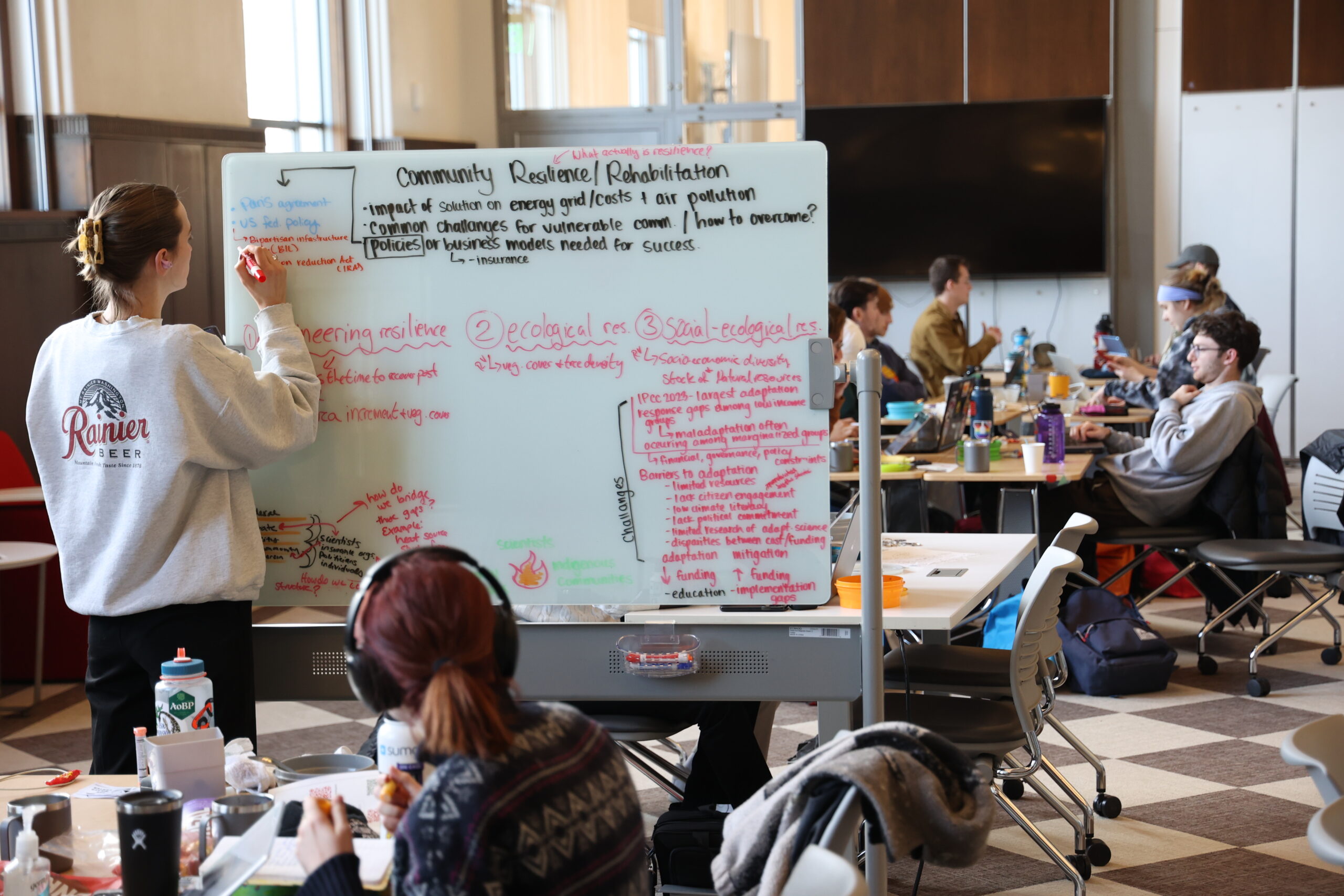
The Wilkes Center held its second annual Climate Solutions Hackathon on January 26th. This was not a coding “hackathon” but a competition to find innovative solutions to the daunting challenges of climate change-driven wildfires. U students were asked to form teams, choose one of five themes to focus their solution, and accomplish this in 24 hours. Ultimately, the Wilkes Center received a total of 17 submissions, with 3 teams winning the top prizes. In this episode I share my interviews with each of the winning teams to learn who they are, what their solutions are, and how they came up with them.
Listen to the Interview:
The 1st Place winning team: Wildfire Resilience Collective
(Rebecca Senft, Hannah Meier, Tegan Lengyel, Elizabeth Williams)
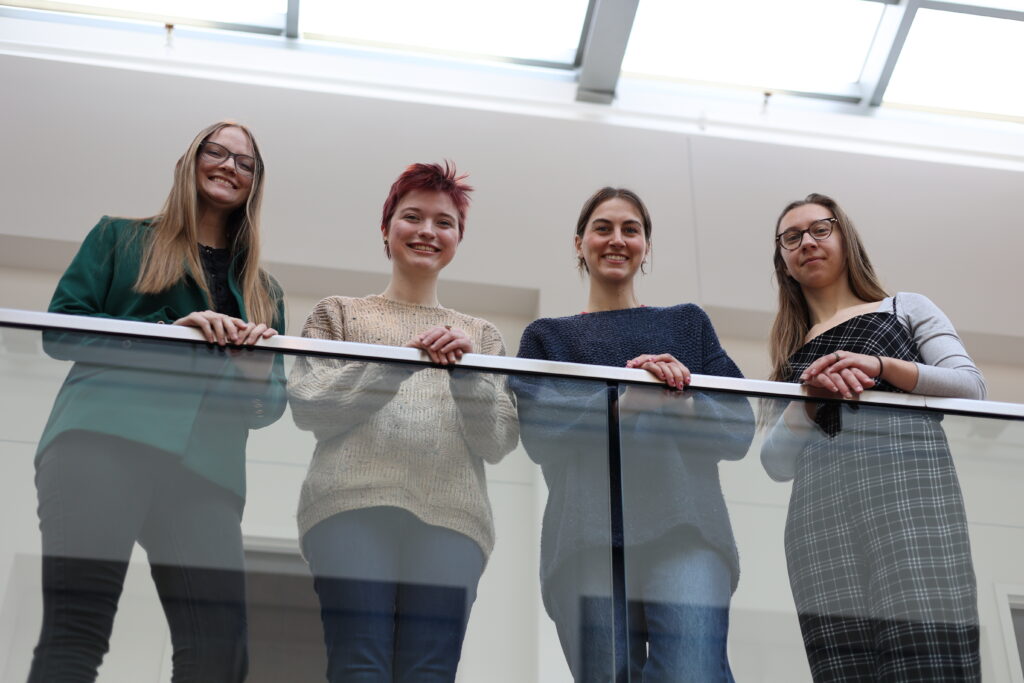
Transcript:
Rebecca Senft
I’m Rebecca. I’m also a first year Ph.D. student in the School of Biological Sciences. My research focuses on invasion ecology. So, looking at plants that aren’t necessarily native to our area and seeing how their physiological mechanisms might help them have a competitive edge in things like climate change.
Tegan Lengyel
Sure. My name is Tegan Lengyel. I’m a first year PhD student at Bill Anderegg’s lab. I study forest health with respect to drought and wildfires. So, this was a really fun opportunity for me.
Elizabeth Williams
I’m Elizabeth Williams. I study biomedical engineering and pediatric clinical health. I just did this because I love research and I like the challenge. So, it’s a little bit outside my scope, but it was exciting.
Hannah Meier
My name is Hannah. I’m a first year PhD student in Jodie Reimer and John Wang’s Labs. I’m an aquatic ecologist, and so I study the community response to climate change in the Great Salt Lake of the phytoplankton and brine shrimp communities.
Ross Chambless
Why did you decide to do the hackathon?
Tegan Lengyel
I can start. So, Bill is my PI, and he is the Director of the Wilkes Center, so that initially inspired me. But I think what was fun with my cohort, and Hannah and Becca are both in my cohort, we have a lot of different ideas and we come from different backgrounds. And so, it’s a really fun idea that we could sit down for 24 hours and lock ourselves in a room and try to think about a really big, broad question. So, I think that was my main driver.
Elizabeth Williams
Yeah, mine was totally different. I saw it in an email, and I was like, Oh, that’s interesting, hackathon? I thought it was originally coding, which I’m learning, and but then it was all about wildfire and I find it very prevalent and important where we live to be educated about it. So, I wanted to try to come up with solutions. So, it was more of a this is an interesting idea to work on.
Hannah Meier
Yeah, like I said, this is very much out of my wheelhouse too. But I lived in California during the big 2020 fires and then moved to Oregon and came here from Oregon. So, I’m very familiar with wildfires. I think about ecological resilience a lot, and I thought it was an interesting opportunity to learn one about what some of my cohort mates are doing. Bill Anderegg is on my committee for my dissertation as well, so I thought it was a good opportunity to get familiar with some of the stuff he does. But also to think from the philosophical background that I have, like what is ecological resilience? What does it mean for community to be resilient, which was like a big thing that I also asked about all the time during the hackathon.
Rebecca Senft
I feel like I have an interesting sort of story here because I actually didn’t sign up until a week before. Like I knew Teagan and like our cohort were talking about it, and I was like, I’m really busy right now. I think all first year PhD students are. So, I was kind of like, Yeah, yeah, whatever. And then like, I don’t know, just the week before I was like, Yeah, I’m going to do it. I’m gonna sit down and actually spend this time with my cohort members and bond and learn about this problem and see what I can throw at the wall that will stick. And then actually ended up working out really well because we had a whole bunch of people drop. I think from our cohort six of them registered and it only ended up being three of us. So, it was, I don’t know, the perfect storm. And then Elizabeth got added to our team and everything just kind of came together right at the last moment, which was cool.
Ross Chambless
Interesting. So, Elizabeth, you didn’t know everyone else on the team before you started?
Elizabeth Williams
No.
Ross Chambless
Okay. So, you were just kind of matched together and it worked out. Very interesting. So, I want to ask how did you decide to make resilience your focus? Why did you think that was the important route to take for a solution?
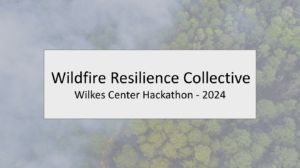 Rebecca Senft
Rebecca Senft
So interestingly, Tegan and I are both in a separate class. We both, and actually also Hannah, we’re both fellows for the Global Change and Sustainability Center. And so, we’re required to take this class that’s an interdisciplinary sort of study, where they get a whole bunch of people from different areas of science into a room and talk about kind of what it means to have interdisciplinary research. And this semester the focus is on climate resilience. So, I think that’s been something that’s been on Tegan and my minds, and I think Hannah touched on it too. And so, I think we were already thinking about that due to other coursework and it just felt like a really natural fit. Yeah, it worked out really well.
Elizabeth Williams
Very quickly in the beginning there was like topics that we could do, we could talk about health… There was a range of topics. And we all just kind of narrowed down to resilience. There was just the topic, and yeah, let’s do that! And then we all just dug into research.
Tegan Lengyel
I think along with being a GCSE fellow too, there’s also a lot of real-world events that are happening right now. Like, the La Haina fires are a great example of wildfire resilience. And you know, the Southwest is drying out drastically and dramatically. And so it’s on a lot of climate scientists’ mind on the forefront of how can we take this wealth of knowledge that we already have and turn it into tangible policy and things that we can do and ways to work together. So, I think it was a really easy pick in the end to aim for resilience in our communities.
Hannah Meier
Yeah, I think also we talk a lot about bringing our science to the community and kind of an interdisciplinary approach, especially in regard to climate change because it impacts so many different sectors. And obviously we all come from really different backgrounds, and I think coming together and coming up with a way to get more people in conversation with one another was something that was really important to us because I think there’s a lot of frustration from all different factors of community towards other factors. And so like, people don’t always know what the scientists are doing or how funds are being allotted. And so that was one thing we really wanted to address. Because we talk so much about outreach, but the amount that we actually do outreach, I think because we get so busy with our research, is relatively limited.
Ross Chambless
Well, and I noticed in your proposal you did focus a bit on the barriers to resilience, and how best to bring expertise and people with knowledge and skills to communities or people that don’t necessarily have access or the resources to help their communities become resilient. So that seems to be a pretty significant part of the proposal. How do you think that might play out in real life, in the real world with this?
Hannah Meier
I think for me, my research is particularly niche. And so, I’ve spent a lot of time thinking about how to get people to care about organisms that they’ve often never even heard of. And I think that we kind of came, I think all of us came, with that kind of a mindset of, okay, we’re taking this not super niche topic anymore, and we’re just trying to make sure that we bring people into conversation. And I think we made connections with people in the Forest Service and talked to him quite a bit and even outside the scope of the hackathon. And I think just continuing those conversations and continuing to bring some of that work into the community is something that we all felt really passionate about and are trying to actively continue to do post Hackathon.
Tegan Lengyel
Yeah, I think we use the IPCC’s most recent report to identify those barriers because there’s a lot of amazing scientists that are already out there on the ground trying to connect these bridges that aren’t fully there yet. And I think for us that was a great tool to utilize in terms of we know that there are these barriers that exist for moving forward and creating tangible policy from climate research that so many of us do every day. So, I think, you know, having that clearly outlined for us already was an advantage. And then from there we could say, what’s the best way to tackle the largest number of these barriers that we possibly can? And there’s just this wealth of knowledge and all of these different people who have specialized expertise in terms of climate resilience and really trying to bridge that gap and bring together all of those individuals who already have a clear idea of what they could do to make a difference was just one of the biggest barriers, was really just communication and working together.
Elizabeth Williams
Yeah, I think along with that, just building trust, like having the community trust, what people are saying. And so, I think that’s why we built it with that. The chapters are based on a university in a local area because people support the sports teams or they support, you know, various things coming from the universities. So that’s kind of a good place to start. And then going from there.
Tegan Lengyel
I think it also adds like a really specialized approach because what we might do here in Utah or southern Utah would be really drastically different than what they might do in Oregon. So, I think individualizing it to each community really allows people to have more of a connection with their own identity, too, and I think that is a stronger motivator for actually taking action towards climate change.
Rebecca Senft
I think it was really cool too, that when we were talking about structure, we made a very clear choice to have the chapters that we are suggesting to be housed in a university and kind of had of it be grad student led and have this structure that comes out of academia but is very clearly supposed to make sure that it doesn’t stay in academia. I think we’re touching on that sort of, you know, you do research and then you publish your results and maybe that’s where it stops. And so, there’s all of these gaps between both land managers as well as the community. And so having a grad student who’s forming their research career right now leading this, then they start modeling that behavior of including the entire community as they’re doing their research. And then that’s something that will go on into the future as they become professors or as they become land managers themselves. And so, you’re starting to model at a really good point, I think.
Hannah Meier
Yeah, I’m just going to add to that, too. I think selfishly, for me, at least as a grad student, I think it just makes our science better to think how do we bring this out to the people who it impacts every day. Because I think there is this kind of idea that, especially with climate change or conservation efforts, people won’t people won’t feel as affected unless it’s happening, quote unquote, “in their backyard.” And I think bringing this bringing people together from these communities to talk about how their communities are impacted and having multiple members from different factions of the community do that is going to be really vital to get people to see that it is happening in their backyard. It’s not just something that’s kind of theoretical and offer the future.
Tegan Lengyel
I’ll add to that even further to I feel like when you start a PhD, you kind of have this idea of like, I’m going to know everything one day, and then you slowly realize, I know a lot about a little. And so, it’s really valuable for me to like, take a health expert into consideration or a land steward into consideration or someone in an indigenous community in their perspective. Because I know so much about what I know, but there’s so much that someone can teach me about their perspective on climate resilience and especially with respect to wildfire, since that was the main goal of the hackathon.
Ross Chambless
Absolutely. I think it’s really interesting and compelling how you’ve created kind of a framework that can be sort of adaptable depending on a various location and what an area’s different concerns are. I saw also that you created a structure as far as who should be involved with this, and you even included elected officials. I think that seems also very important to be engaging with the sort of political process as far as how policies get made, too. Can you talk about how that kind of factored in?
Tegan Lengyel
Yeah. Policy is something that I’m really interested in including in my research for my Ph.D. Because what is great knowledge if we don’t apply it to things. And I think there can be a real disconnect, especially because there’s a lot of tribalism associated with politics in the current atmosphere. And so, I think this is a nice way to kind of bridge that gap and build lasting relationships that will go beyond my relationship with my own cohort or with my own PI. And I can have a relationship with my local politicians and express my concerns and my investments to them. And they will hopefully take that further and do the things that I can’t do with that information. So yeah, I think it’s a really good way to kind of connect to communities to their local politicians as well, which is important.
Hannah Meier
Yeah, I think especially for me, I mentioned I work with the Great Salt Lake and coming into my Ph.D. I didn’t realize what a hugely political system that is in and of itself and how much politics there already inherently is in my research and how much I talk to the state and things like that. And I think it’s a really great opportunity for me. But I also think that it would be nice, you know, the state does a lot of work on the Great Salt Lake and a lot of that work is state knowledge, but not public knowledge. And even as a researcher, the only way I found out about it was by talking with members of the state.
So I think it would be nice if some of that information was more widely available if those conversations were a little easier to have and there weren’t so many barriers for maybe the everyday person to understand what’s going on in the system and what work is being done versus what work is not being done. Because I think from an outside perspective, there is this feeling that not a lot of research is happening in the lake, and that’s actually very much not the case. And so, I think that also translates really well to other systems. Obviously, I think that’s the case with wildfires too. And just bringing more people into those conversations is hugely important.
Rebecca Senft
To address outside of the politician, but also especially with the politician aspect of chapter membership, we wanted every person that was a part of a chapter to be an advocate. Like, I live in a university and that’s my community, but that politician is a member of the political community. And so, like Hannah was saying, sometimes it’s really hard to get information you need or request data that exists. And that’s just because people that don’t live in your world don’t know you. And so, if you have that advocate that you that have a connection to, you can use that advocate to be a face that people are familiar with. So, I think oftentimes a lot of actual tangible action gets done just because somebody knows somebody. And so that’s kind of the thought. If we build real faces into all of these different worlds, then we have a route that we can go when we need data or we want to have an event or any of these very tangible things become so much more doable because now, you know somebody. So I think that was part of the thought there as well.
Ross Chambless
Yeah, interesting point. Also, I think you mentioned you also were able to build some good connections with the Forest Service, with a local Forest Service advocate. And we had we’re really lucky to have some folks from our local Forest Service divisions to be here to kind of help with with the student projects. And I’m just wondering if you could talk about a little bit how that sort of helped to shape the the the ultimate form of your your proposal?
Tegan Lengyel
You guys are looking at me because Kyle and I got along very well. But yes, we met Kyle Yurkovich from the Forest Service, and he had some really amazing constructive feedback for us that really helped us kind of launch the correct trajectory here. And it’s really exciting, I think, as students and people who are just invested in this atmosphere, to have other folks be excited about your work and to see the potential in it. Because I think we can feel like these problems are so big and climate grief can be a really huge thing to deal with. And I think seeing other people say, Oh, that’s actually a really cool idea. And that’s something that I think we could take forward. Can I take this to my boss? That was thrilling for us to have actually done something that we felt like was worthwhile.
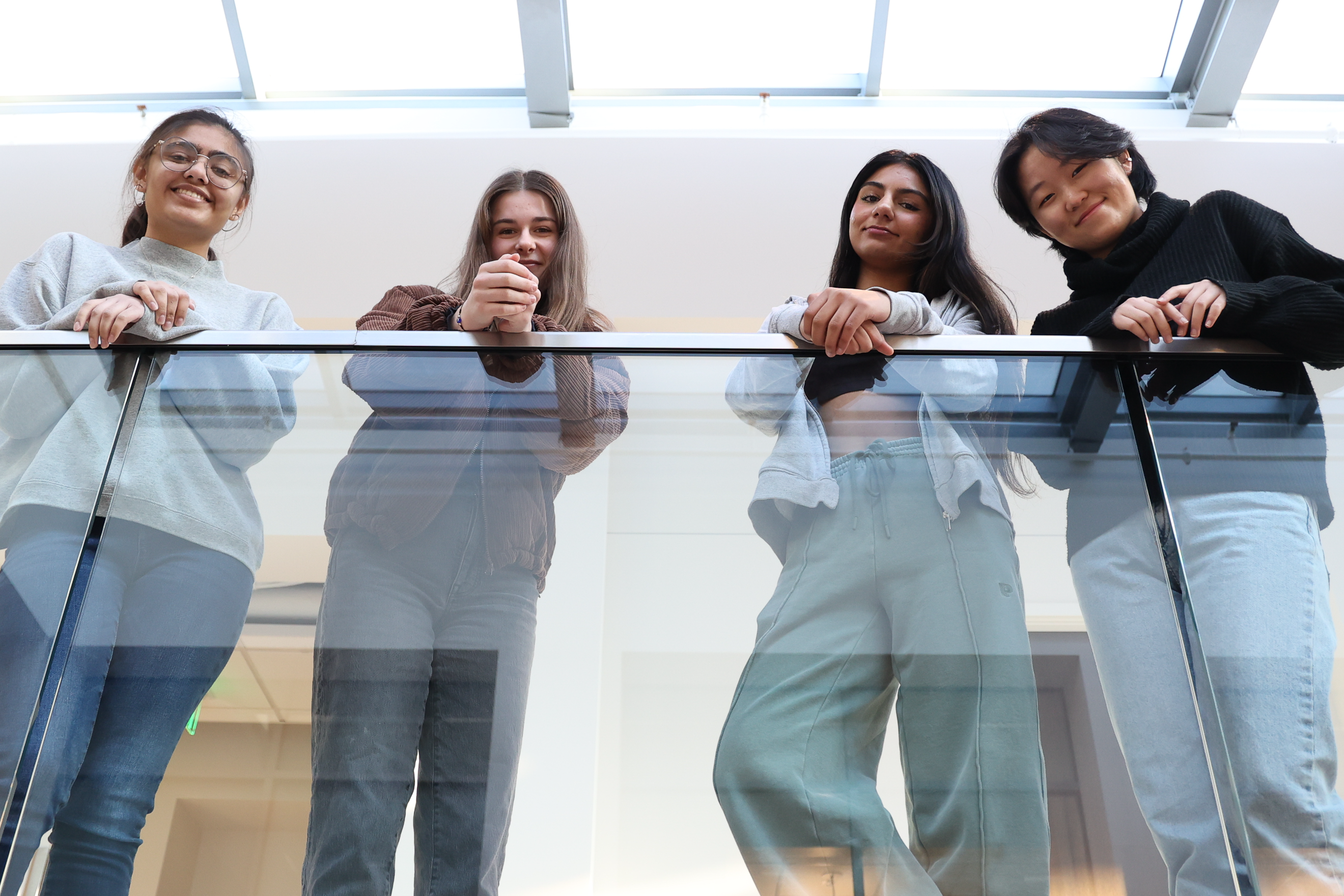
The Second Place WinningTeam: Fire Nest
(Kalina Manova, Suhaani Shelat, Navi Brar, Sarah Choe)
Transcript:
Suhanni Shelat
We came up with a home development company. We develop homes like communities that are fire safe, and we also work to make older homes like modular installments that make older homes more power state, especially in wildfire prone zones.
Ross Chambless
Okay. So, from what I gather, it’s kind of essentially an affordable a more affordable, a more resilient, a protective sort of housing structure for people who are living in high risk areas for wildfire areas, essentially. Is that kind of it? So, how did you kind of come around to this to focusing on this particular topic?
Sarah Choe
On the night before leading up to the hackathon, we had a couple of phone calls up, just like brainstorming and really basically brain barfed. All the ideas that we had, some of the ideas that we had during those phone calls were like regarding architecture and urban designing. So, something about like area codes and talking about like how policy and like insurance can affect that. Another idea we had about was like exterior coverings for homes and along others similar ideas regarding architecture and home and homebuilding. We combine a bunch of those and incorporate into what we now have as fire nest.
Ross Chambless
And then focusing on the wildland urban interface and the need for better evacuation strategies. Was that an area that you had interest in before hackathon? Was that something that you sort of just came across and thought, oh, this is what we want to focus on?
Navi Brar
I think when we first started, we were looking at a really broad picture of like designing like an architecture that was fired like through a quiet wildfire, safe and like, I guess like more research to talk to experts and all that. We kind of drawn more to a lot of evacuation plans, a lot of more specific materials, designs, how we would implement it, and really gotten into the specifics of it. And that’s kind of where we really were able to, like, narrow the scope of our idea.
Ross Chambless
Okay. Just curious if there was any particular article or resources that influenced your choice or some of the ideas that you put into your idea, your submission from your research?
Kalina Manova
It was mostly just about all of our backgrounds because Sarah, now we especially have a lot of experience with like policy and I don’t know, I know they did stuff in high school that was related to that.
Ross Chambless
And then, one of the curious things I had a question I had is that you kind of looked at you kind of came to a conclusion that current fire safe building solutions aren’t effective. How did you reach that conclusion?
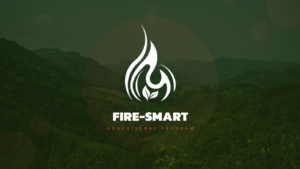 Kalina Manova
Kalina Manova
Yeah. So that was a lot of my section. Unfortunately, a lot of the fire prone areas are not really fire resistant, just due to poor planning. There aren’t really many laws that enforce it. Even after a wildfire has burned through an area like I know, even California, in places where wildfires are a huge issue, there isn’t really much of like a demand to enforce any sort of policy that will mandate that they use fire safe materials. Maybe some structures like some structural components of it are recommended, but they’re not enforced even though a lot of the time they’re a lot cheaper to implement as opposed to non-fire-safe housing. I think there’s just a general lack of education regarding fireproofing housing because a lot of the time it does come out to be cheaper as we concluded from our project. And I don’t know if cities and governments maybe are intimidated by it or it’s hard to convince people.
Ross Chambless
Very interesting. Well, I think you did a lot of work into trying to think of a solution also that would address various co-benefits, sort of like addressing the housing crisis and helping low income communities and mitigating health impacts, as well as addressing the insurance industry, which has sort of been dropping coverage of areas with of high fire risk. Right?
Navi Brar
Okay. I think especially when you’re looking at the insurance and all of that, especially when talking to experts on the day of… I wish I could remember if made off the top of my head.
Kalina Manova
Sierra Hellstrom, I think.
Navi Brar
Yeah. Sierra Hellstrom. She was a property specialist. So, after talking to her, she brought up a lot of the insurance issues. She kind of borrowed a lot of transportation issues and she kind of helped us really broaden our view on the issue itself, like how you can have a bigger impact on like what we just originally thought we were able to do. And so, I think that was definitely a really great resource for us.
Ross Chambless
Good. And you also incorporated some climate justice aspects into your idea as far as really just trying to serve underprivileged communities, right?
Sarah Choe
Yeah. So, our initial audience was meant for houses that were in like the mountains and like people would have a for those kind of housing situations. But as we thought about how we could make this plan more implementable by other communities, because our development company’s goal at the end of the day is to help communities become more fire resistant and be able to come back easier economically and wiser from natural disasters like fires, we started thinking about how can we incorporate this in a way that everyone can have these kind of homes. So, then we started expanding into those kind of areas of interest.
The Third Place winning team: Fire Smart Educational Program
Gaby Karakcheyeva, Celine Cardena, Brandon Saavedra, Xuan Hoang, Shreesh Srivastava)
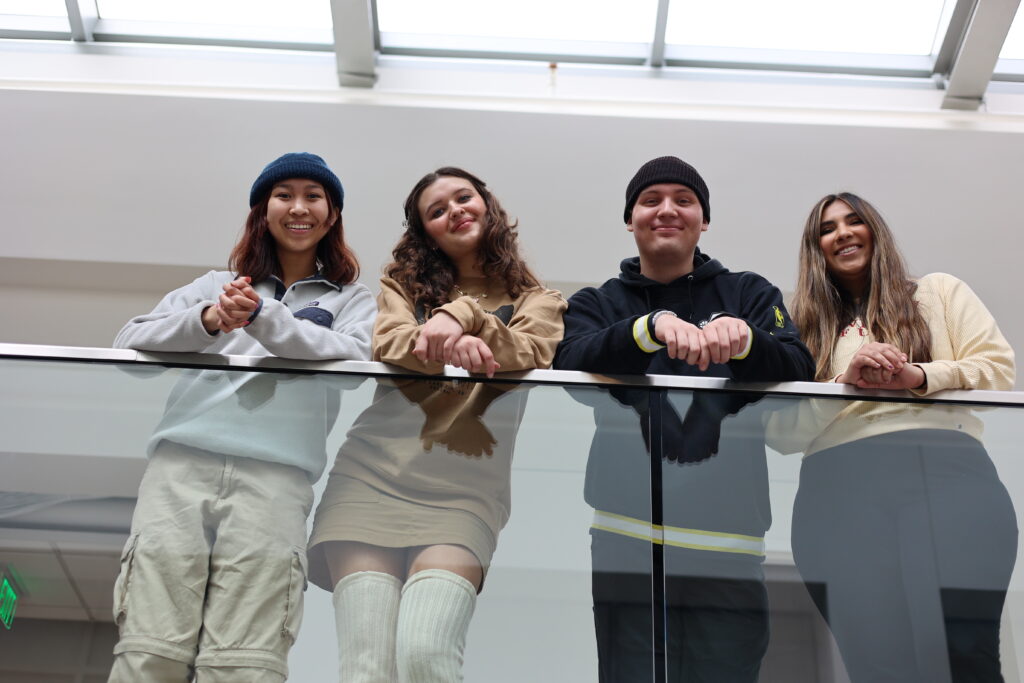
Transcript:
Gaby Karakcheyeva
Well, I mean, honestly, I have a little bit of background with like climate related things. I had no context on wildfire. I saw it happening last year with the urban heat thing. I was like, Oh, that’s really cool. I thought about doing it, but I just didn’t know who wanted to do it with me last year. So, this year I was like, guys please do the hackathon with me. I really want to learn about something new! So yeah, I did have some pre-exposure at least myself with climate change stuff. I do climate change related research, but not with wildfire specifically.
Celine Cardena
So, I’m going to be honest. Gaby was the one who really encouraged especially me, to get involved with this. I guess I’m clearly not a STEM major. I’m very much in the social sciences, but something that we were thinking about was it would be really cool to have people from different majors and be able to use our own strengths into what we know, into what we developed into Fire Smart. I mean, I’m pretty familiar with the public education in Utah, so that was really interesting. But also, everyone here is very insightful and a lot of their own interests and strengths.
Ross Chambless
So, you mentioned education, and let’s pivot to that for what your focus of your proposal was. You really seemed focused on building what might become a curriculum focused on K-12 education — wildfire education. Why did you decide to take that route?
Gaby Karakcheyeva
Well, I do citizen science work, so I’m very familiar with citizen science. And initially I pitched the idea of, oh, we should develop something that could teach people how to contribute to citizen science. Then it kind of grew from there into an educational program because we spoke to someone who works in the Forest Service. I don’t remember who it was, unfortunately, but they did mention the Fireworks Educational Program that the Forest Service was developing and from there we kind of just took off focusing on K-12 education and really expanding that.
Brandon Saavedra
I don’t know, it was funny because we didn’t really think of education coming into it, and then it just kind of grew into this whole thing. I don’t know how else to build off of that. It was funny to see how it came out of nowhere and became like this whole curriculum that we planned out different uses for, for every single year.
Ross Chambless
Interesting. So, your process of reaching the solution was kind of organic would you say? You didn’t come in with a predetermined idea, it just came out from your conversations?
Brandon Saavedra
I think we all had like preconceived ideas of what we wanted to do. It was for me.
Gaby Karakcheyeva
I did too.
Brandon Saavedra
I came into it thinking maybe we can make a community center that we could design that was focused on fighting fires and educating. And I don’t know about you guys, but that’s what I thought, and then it turned into the educational program.
Ross Chambless
Interesting. So, what is it specifically that you feel like is lacking in current the current education system and made you think wildfire needs to be play a larger role?
Gaby Karakcheyeva
That’s a really good question. I mean, honestly, I don’t know about you guys, but I got like zero wildfire education growing up. I don’t know, I’m from the East Coast originally, so we didn’t really talk about that there. And I really had no education on it. And a lot of the areas that have a lot of human-caused wildfire also don’t necessarily have a lot of specific wildfire-focused education. So, we were like, it would be really nice if we could teach people to not start wildfires and teach people to appreciate nature and all that stuff.
So, really, there’s just not a lot of conversation about it. At least in my experience. I was not taught at all about it. I don’t know about you guys, but literally not at all. So that’s a really important thing, especially since it’s going to become more and more and more prevalent. Because there’s of course a certain amount of natural fire that’s completely cool and acceptable and it could actually be really beneficial for an eco-system. But then there’s also silly fires that are caused by silly people doing silly things that we can easily prevent just by educating people, especially at a young age.
Ross Chambless
Yeah, interesting. So it seemed like you focused on the fact that a large majority of wildfires are human-caused or caused by human activities, which is true. But it is such a complex phenomenon, right? There’s so many aspects to it. And you were given a choice as far as the prompts, right? You could take different routes as far as risk mitigation or focus on health impacts. It seems like your idea is in the community resilience or risk mitigation area. Would you agree?
All
Yeah.
Ross Chambless
Okay. Well, when I was going through your proposal — and I really hope that anyone who listens to does check it out, because it is really cool, and we have it online — that it does feel like you were trying to explain how this could be feasible potentially, right, and actually be implemented to some degree? And it could even be like a recruitment tool, if for students who are interested in going into like wildland forest management or that kind of area. Was that kind of intentional or did that just sort of come out of your work?
Celine Cardena
I wouldn’t want to say that it was directly intentional. Because, I mean, of course we want to be able to educate our future generation on the risk of wildfires and wildlife management. So, when we were talking to one of the park rangers, we also gained a sense of understanding that there’s not a lot of them. And that is definitely something that needs to be more encouraged within our public education system, especially when it can be like an open door for students. Because it’s not something that they’re necessarily introduced to at a young age, you know. I think firsthand experience really helps students pique their interest and what they want to pursue. And being able to inspire our future generations and people who are currently in the K-through-12 public education system, it really helps encourage them into understanding our current backyard, which is the great outdoors. We have the beautiful mountains right behind us. It’s a way for them to get more familiar with their environment and being able to support it and be able to reduce the amount of people-caused wildfire.
Ross Chambless
Defintely. Other thoughts on that?
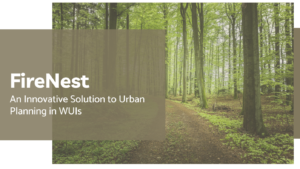 Gaby Karakcheyeva
Gaby Karakcheyeva
For me personally, I mean the recruitment I guess aspect of it is really important. I don’t know, for me I was kind of coming into it hoping to do a citizen science focused thing because I think that’s really important and getting as much data as we can and teaching people how to be active in science is really important. And it’s really important to me. And I think that exposures like that at a young age can be really helpful and really impactful, and especially for me in college when I was able to really like experience going out in the field and being like a scientist or doing things that are related to things that I’m interested in, just trying new things that I haven’t before. That really helped me shape what I wanted to do. So, I thought incorporating that would be really, really awesome. And it could really connect people to higher education and really help a lot of students who might not have direct access to a close university or maybe direct access to something relating to research or higher education to really get opportunities where they could thrive and succeed and try something that they had and before. So, that was something that I thought was really cool about our project too.
Ross Chambless
Yeah, well, I’m interested, how did you go about doing research for this project? Was it sort of on the spot, or did you do a little bit of preliminary work going into the hackathon or was it just sort of like on the fly, like, let’s just learn about this and put it out there? How did it how did it happen?
Brandon Saavedra
I think we’re just going. As it went on, this is a cool idea, let me look into it. And we just we would just come back to the team and share our findings. Also, I know Celine’s mom is on the State Board of Education?
Celine Cardena
Yeah, she was on the Utah State Board of Education. Yeah. So, being able to understand from that perspective the Utah State Board of Education with what we developed into Fire Smart, I mean, according to their guidelines of what the guidelines are for science should be for K-12, they should honestly be very on board with it because they do see very hands on opportunities. And being able to contribute and understand the environment that students currently live in, and being able to do field work and engage with our environments, is something that isn’t necessarily too far-fetched from what the Utah State Board of Education is seeking.
Ross Chambless
That’s interesting that you could sort of take a personal connection to the policymaking world and apply it, which is great. I’m always just curious how the creative process plays out with these kinds of events and what comes out of it.
I think some of the partnerships you identified in your proposal were interesting, too. You mentioned the Unified Fire Authority here in Salt Lake County and Forest Service as potentially playing a role with this sort of program. Where did that come from?
Xuan Hoang
I felt like it was a natural fit? Just thinking back on like our education, like we remember the DARE Program and how that was kind of influential. Like, seeing officers in our classrooms, you know, and being there and having someone to look up to and really associate with what we’re learning. I have a friend’s dad who works at the Unified Fire Department, so that kind of just came to me. And then I think talking to the Rangers really helped us kind of click that together as well.
Ross Chambless
Very cool. So, I guess the question is what happens from here on out? I mean, obviously this is an interesting creative activity to come up with an idea, but it is just an idea. Do you have any thoughts on how this experience might have impacted your thinking as wildfire resiliency or education programs you might take going forward?
Gaby Karakcheyeva
Yeah. Honestly, I had not a lot of exposure to wildfires before, so it was really cool just personally to look into it. Because I’m really interested in like plants and especially plants responses to climates and just everyone’s responses to climate. So personally, I just thought it was a really enriching experience. Also learning a lot more about the education system and what we can actually feasibly do is also very beneficial for me. And I feel like after the fact that this could be like a really cool like thesis project or initiative to work on. Because it’s relatively feasible, especially considering the fact that Fireworks already has all the materials they have basically everything that you could possibly need to get it started and all you really need to do is just get that approval and get it going, get people trained. And from there it could work pretty smoothly after a few practice runs. So, I think it could really grow into a lot of potential. And I think that education ultimately is one of the best ways to solve like 90% of the world’s problems. So, it was definitely really a really fun time for me to learn a lot more about it and how the intricacies of it worked. It really made me consider things that I wouldn’t consider before. I was working on the proposal in the morning, like 5 minutes before it was due, and I was like, Oh, I wish I included this, or I wish I thought about that, because a lot of things and lots of questions pop up after the fact.
Ross Chambless
Awesome. Well, thank you so much, Gabby, Celine, Brandon, and Xuan, for talking with me about your proposal. And again, check it out on the Wilkes Center website. It’s Team Fire Smart Educational program and we’re talking to all the finalists for the hackathon for this podcast. And one more thing, I should mention is that we’ll plan on seeing a poster from you guys right at the Wilkes Summit in May so you can look forward to that and learn more. And yeah, thanks again.
All
Thank you.
One thought on “15: Talking with the Wildfire Hackathon Winners”
Comments are closed.